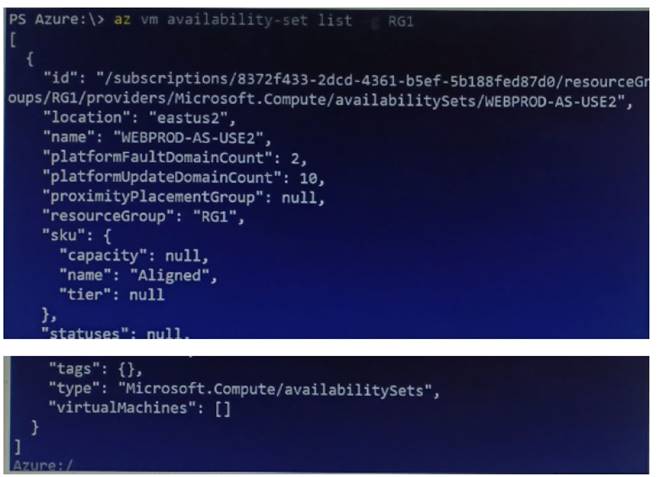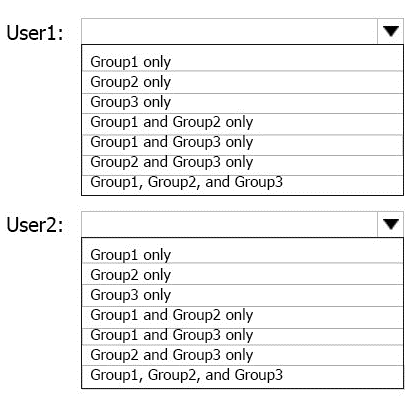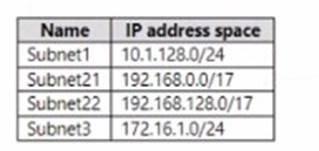HOTSPOT - (Topic 5)
You have an Azure virtual machine named VM1 that connects to a virtual network named VNet1. VM1 has the following configurations:
✑ Subnet: 10.0.0.0/24
✑ Availability set: AVSet
✑ Network security group (NSG): None
✑ Private IP address: 10.0.0.4 (dynamic)
✑ Public IP address: 40.90.219.6 (dynamic)
You deploy a standard, Internet-facing load balancer named slb1. You need to configure slb1 to allow connectivity to VM1.
Which changes should you apply to VM1 as you configure slb1? To answer, select the appropriate options in the answer area.
NOTE: Each correct selection is worth one point.
 Answer:
Answer:
Solution:
Box 1: Remove the public IP address from VM1
If the Public IP on VM1 is set to Dynamic, that means it is a Public IP with Basic SKU because Public IPs with Standard SKU have Static assignments by default, that cannot be changed. We cannot associate Basic SKUs IPs with Standard SKUs LBs. One cannot create a backend SLB pool if the VM to be associated has a Public IP. For Private IP it doesn't matter weather it is dynamic or static, still we can add the such VM into the SLB backend pool.
Box 2: Create and configure an NSG
Standard Load Balancer is built on the zero trust network security model at its core. Standard Load Balancer secure by default and is part of your virtual network. The virtual network is a private and isolated network. This means Standard Load Balancers and Standard Public IP addresses are closed to inbound flows unless opened by Network Security Groups. NSGs are used to explicitly permit allowed traffic. If you do not have an NSG on a subnet or NIC of your virtual machine resource, traffic is not allowed to reach this resource. To learn more about NSGs and how to apply them for your scenario, see Network Security Groups. Basic Load Balancer is open to the internet by default.
Does this meet the goal?
Correct Answer:
A
- (Topic 5)
You are configuring Azure AD authentication for an Azure Storage account named storage1.
You need to ensure that the members of a group named Group1 can upload files by using the Azure portal. The solution must use the principle of least privilege.
Which two roles should you assign to Group1? Each correct answer presents part of the solution.
NOTE: Each correct selection is worth one point.
Correct Answer:
AB
To ensure that the members of Group1 can upload files by using the Azure portal, they need to have both data access and management access to the storage account. Data access refers to the ability to read, write, or delete blob data in the storage account. Management access refers to the ability to view the storage account resources in the Azure portal, but not modify them. The Azure role-based access control (Azure RBAC) system provides built-in roles that encompass common sets of permissions for data access and management access. The Storage Blob Data Contributor role grants read, write, and delete access to blob data in the storage account. The Reader role grants view access to the storage account resources in the Azure portal. Therefore, by assigning both roles to Group1, the members of the group can upload files by using the Azure portal. This solution also follows the principle of least privilege, as the group members are only granted the minimum permissions required to perform the task. References:
✑ Assign an Azure role for access to blob data
✑ Data access from the Azure portal
HOTSPOT - (Topic 5)
You have an Azure subscription that contains an Azure Availability Set named WEBPROD- AS-USE2 as shown in the following exhibit.

You add 14 virtual machines to WEBPROD-AS-USE2.
Use the drop-down menus to select the answer choice that completes each statement based on the information presented in the graphic.
NOTE: Each correct selection is worth one point.
Solution:
Box 1: 2
There are 10 update domains. The 14 VMs are shared across the 10 update domains so four update domains will have two VMs and six update domains will have one VM. Only one update domain is rebooted at a time.
Therefore, a maximum of two VMs will be offline. Box 2: 7
There are 2 fault domains. The 14 VMs are shared across the 2 fault domains, so 7 VMs in each fault domain.
A rack failure will affect one fault domain so 7 VMs will be offline.
Does this meet the goal?
Correct Answer:
A
HOTSPOT - (Topic 5)
You have an Azure Active Directory (Azure AD) tenant named adatum.com. Adatum.com contains the groups in the following table.
You create two user accounts that are configured as shown in the following table.
To which groups do User1 and User2 belong? To answer. select the appropriate options in the answer area.
NOTE: Each correct selection is worth one point.
Solution:
Box 1: Group 1 only First rule applies
Box 2: Group1 and Group2 only Both membership rules apply.
References: https://docs.microsoft.com/en-us/sccm/core/clients/manage/collections/create- collections
Does this meet the goal?
Correct Answer:
A
HOTSPOT - (Topic 5)
You have an Azure subscription that contains the virtual networks shown in the following table.
The subnets have the IP address spaces shown in the following table.
You plan to create a container app named contapp1 in the East US Azure region.
You need to create a container app environment named con-env1 that meets the following requirements:
• Uses its own virtual network.
• Uses its own subnet.
• Is connected to the smallest possible subnet.
To which virtual networks can you connect con-env1, and which subnet mask should you use? To answer, select the appropriate options in the answer area.
NOTE: Each correct selection is worth one point.
 Answer:
Answer:
Solution:
✑ Virtual Network: You can connect con-env1 to VNet2 and VNet3 only. This is because VNet1 is in a different region than the container app, which is East
US. According to the web search results, you can only connect a container app environment to a virtual network that is in the same region as the container app1. Therefore, VNet1 is not a valid option. VNet2 and VNet3 are both in the same region as the container app, and they have enough available IP addresses to support a container app environment.
✑ Subnet mask: You should use /28 as the subnet mask for con-env1. This is
because /28 is the smallest possible subnet mask that can accommodate a container app environment. According to the web search results, a container app environment requires a minimum of 16 IP addresses in a subnet2. A /28 subnet mask provides 16 IP addresses, while a /26 subnet mask provides 64 IP addresses, a /24 subnet mask provides 256 IP addresses, a /23 subnet mask provides 512 IP addresses, and a /16 subnet mask provides 65,536 IP addresses. Therefore, /28 is the most efficient choice for minimizing the subnet size.
Does this meet the goal?
Correct Answer:
A

